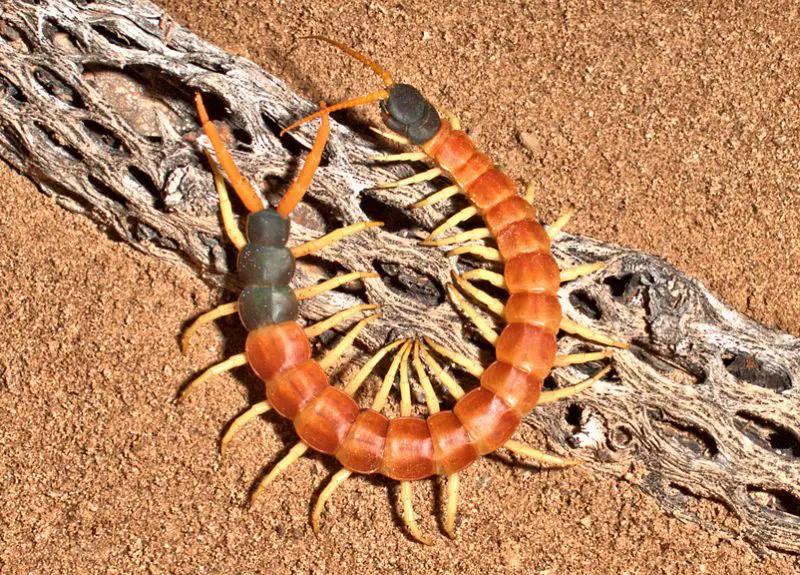In the wild and urban corners of Arkansas, few creatures inspire both curiosity and fear quite like the centipede. With their countless legs, lightning-fast movements, and surprising hunting abilities, these arthropods have a reputation that lies somewhere between awe and fear. Many Arkansans have encountered centipedes in basements, gardens, or even bathtubs—but few truly understand what these creatures are or what makes them thrive in the state’s environment.
Despite their menacing appearance, centipedes are not insects—they belong to a distinct class of arthropods called Chilopoda. They are ancient predators, having roamed the Earth for more than 400 million years, long before dinosaurs ever appeared. In Arkansas, several species of centipedes live both outdoors and indoors, playing vital roles in the ecosystem.
This article explores the most amazing yet terrifying facts about centipedes in Arkansas—their biology, behavior, habitats, dangers, and their surprising benefits to humans. By the end, you’ll see these many-legged creatures in a completely new light.
Understanding Centipedes in Arkansas

What Exactly Are Centipedes?
Centipedes are elongated, segmented arthropods characterized by having one pair of legs per body segment. Depending on the species, they may have anywhere from 15 to more than 300 pairs of legs. Unlike millipedes, which are herbivorous and slow, centipedes are active predators, using venomous fangs to capture and subdue prey.
Their bodies are flexible and covered with a thin exoskeleton that allows them to slip into cracks, soil, and leaf litter. Each leg moves independently, giving them remarkable speed and agility—some species can sprint faster than most insects.
Centipedes Commonly Found in Arkansas
Arkansas hosts several species of centipedes, but the most commonly seen ones include:
-
The house centipede (Scutigera coleoptrata)
-
The eastern red centipede (Scolopocryptops sexspinosus)
-
The giant desert centipede (Scolopendra heros)—though more common in neighboring states, it occasionally appears in southern Arkansas.
These species differ in color, size, and behavior, but they all share one trait: they are efficient nocturnal hunters that feed on insects, spiders, and even small vertebrates.
The Creepy Yet Fascinating Anatomy of a Centipede
Built for Hunting
Centipedes are designed to be perfect predators. Their first pair of legs has evolved into venom-injecting fangs called forcipules. These fangs pierce prey and deliver venom that paralyzes small insects almost instantly. Despite their size, some centipedes can overpower prey several times larger than themselves.
They also have sensitive antennae that detect vibrations and chemical signals in the environment, allowing them to locate prey even in complete darkness. Their compound eyes, though simple, are capable of sensing movement efficiently.
The Many-Legged Illusion
One of the most common myths about centipedes is that they have 100 legs. In reality, the number of legs always varies depending on the species and life stage. Each species has an odd number of leg pairs—ranging from 15 to over 177 pairs—but never exactly 100.
House centipedes, for example, typically have 15 pairs of long, slender legs, which help them dart across walls and floors at impressive speeds. The larger Scolopendra species, found occasionally in Arkansas’s southern woodlands, have shorter but thicker legs capable of supporting their heavier bodies.
The Role of Venom
The venom of a centipede is both fascinating and fearsome. It contains a mix of proteins and enzymes designed to immobilize prey quickly. For humans, centipede venom rarely causes serious harm but can lead to intense pain, redness, and swelling at the bite site.
Larger species like Scolopendra heros can deliver painful bites that feel similar to a wasp sting. Fortunately, such encounters are rare in Arkansas, and centipedes only bite when handled or trapped against the skin.
Centipedes in Arkansas Homes
Why Centipedes Enter Houses
Centipedes thrive in moist, dark environments—making basements, bathrooms, and crawl spaces ideal habitats. In Arkansas, centipedes often invade homes during periods of heavy rain or drought when they seek shelter from extreme outdoor conditions.
They are especially drawn to areas where insects are abundant, such as under sinks, near drains, and in laundry rooms. Since centipedes feed on pests like cockroaches, termites, and silverfish, their presence often indicates another underlying pest problem.
Are Centipedes Dangerous Indoors?
While their appearance can be alarming, centipedes are not dangerous to humans or pets. In fact, they can be beneficial, as they help control populations of other unwanted household insects. However, their quick movements and eerie look make them unwelcome guests for most people.
House centipedes in Arkansas are relatively harmless. They can move incredibly fast, sometimes reaching speeds of 1.5 feet per second. Their long legs allow them to climb walls and ceilings with ease, often startling homeowners when spotted.
How to Keep Centipedes Out of Your Home
To prevent centipedes from entering your home, follow these steps:
-
Reduce indoor moisture by using dehumidifiers in basements and bathrooms.
-
Seal cracks and gaps around windows, doors, and foundation walls.
-
Keep drains clean and unclogged.
-
Remove piles of leaves, mulch, or wood close to the house.
-
Control other insect populations, as centipedes often follow their prey indoors.
By maintaining a dry, clean environment, you make your home far less inviting to these nocturnal hunters.
Amazing Yet Terrifying Facts About Arkansas Centipedes
They Can Regrow Legs
Like many arthropods, centipedes can regenerate lost legs. This ability helps them survive encounters with predators and accidents during molting. Although regrown legs may not be as strong or long as the originals, they still function effectively.
Some Species Glow in the Dark
Certain centipede species emit a faint greenish glow, especially when disturbed. This bioluminescence, caused by chemical reactions in their exoskeleton, may serve as a defense mechanism or warning signal. While not all Arkansas species exhibit this glow, some desert and woodland centipedes in nearby regions do.
They Are Lightning-Fast Predators
Centipedes are among the fastest arthropod hunters on land. They use their speed and venom to capture prey before it can escape. Once caught, they wrap their legs around the victim and inject venom to immobilize it instantly.
House centipedes, in particular, are skilled hunters that use their long legs to entangle multiple prey at once. They can climb walls, ceilings, and even move upside down to catch insects hiding in corners.
Centipedes Are Ancient Survivors
Fossil evidence suggests that centipedes have existed for over 400 million years, making them one of the oldest land predators on Earth. Their basic body structure has changed very little over time, a testament to their evolutionary success.
They Have Remarkable Lifespans
Many people assume centipedes live only a few months, but larger species can live several years. House centipedes, for example, can survive up to five years under the right conditions. They molt several times during their lifespan, shedding their exoskeleton as they grow.
The Giant Desert Centipede: Arkansas’s Scariest Visitor
Identification and Size

The giant desert centipede (Scolopendra heros) is one of the largest centipedes in North America. While more common in Texas and New Mexico, it occasionally appears in southern and western Arkansas, particularly in warm, rocky areas.
These centipedes can reach lengths of 6 to 8 inches, with bodies colored in shades of orange, red, and black. Their size and coloration make them one of the most intimidating arthropods in the region.
Behavior and Habitat
Despite their fierce appearance, giant desert centipedes are reclusive and avoid humans. They spend most of their lives hiding under rocks, logs, and leaf litter. They emerge mainly at night to hunt insects, small frogs, and even lizards.
Their venom is potent enough to subdue larger prey, though it rarely causes serious harm to humans. Still, a bite can cause intense localized pain and swelling that may last several hours.
The Bite Experience
People who have been bitten by Scolopendra heros describe the pain as burning, throbbing, and radiating through the limb. Fortunately, symptoms usually subside within a few hours to a day. Applying a cold compress and taking over-the-counter pain relievers can ease discomfort.
Because these centipedes are uncommon and non-aggressive, the chances of encountering one in Arkansas are quite low.
Centipedes’ Role in Arkansas Ecosystems
Natural Pest Control
Centipedes are essential components of Arkansas’s natural pest control system. They feed on cockroaches, termites, crickets, ants, and spiders—all species that can become nuisances to humans. Their predatory behavior helps maintain ecological balance by keeping insect populations in check.
Soil Health and Decomposition
By burrowing and moving through soil and leaf litter, centipedes contribute to soil aeration and nutrient cycling. They help break down organic matter, which supports healthy plant growth. This makes them vital to forest ecosystems across the Ozark and Ouachita Mountains.
A Food Source for Other Animals
Centipedes themselves are prey for birds, amphibians, reptiles, and small mammals. Their presence supports a complex food web that sustains biodiversity in Arkansas’s forests and wetlands.
The Myths and Misunderstandings About Centipedes
Myth 1: Centipedes Chase Humans
This is one of the most common misconceptions. Centipedes do not chase people—they run toward dark, enclosed spaces when threatened, which sometimes happens to be in your direction. Their goal is to escape, not attack.
Myth 2: All Centipedes Are Dangerous
Most centipedes in Arkansas are harmless to humans. Their venom is designed to subdue small prey, not large animals. Only a few large tropical species have venom strong enough to pose a risk to humans, and those species do not live in the state.
Myth 3: Killing Centipedes Is Necessary
In truth, centipedes can be beneficial allies in keeping homes pest-free. Rather than reaching for insecticide, homeowners can simply relocate them outdoors. Eliminating excess moisture and sealing entry points is a more effective long-term strategy than extermination.
How to Handle a Centipede Encounter
If You See One Indoors
If you find a centipede inside your home, remain calm. Do not attempt to crush it, as they are fast and can release an unpleasant odor when squished. Instead, use a container and piece of paper to gently trap and release it outdoors.
Inspect your home for moisture issues and gaps around windows or drains. Reducing humidity levels is key to discouraging future visits.
If You Are Bitten
Centipede bites are rare and generally harmless. Wash the area with soap and water, apply a cold compress, and take pain medication if needed. Seek medical attention if you experience severe pain, allergic reactions, or swelling that persists for more than a day.
FAQs About Centipedes in Arkansas
Are there poisonous centipedes in Arkansas?
All centipedes are venomous to some degree, but none in Arkansas are deadly to humans. Their venom may cause localized pain and irritation, but serious reactions are rare.
What attracts centipedes to homes in Arkansas?
Moisture, darkness, and the presence of other insects attract centipedes indoors. They thrive in basements, bathrooms, and areas with leaky pipes or damp walls.
Are centipedes beneficial or harmful?
Centipedes are beneficial because they help control other pests. They become a nuisance only when they invade homes in large numbers.
Do centipedes bite humans often?
Bites are uncommon and usually occur only when centipedes are handled or accidentally trapped against the skin.
How big can centipedes grow in Arkansas?
Most centipedes in Arkansas measure between 1 and 3 inches, but the giant desert centipede can grow up to 8 inches long.
How can I prevent centipedes from entering my home?
Keep your home dry, seal cracks and entry points, clean up clutter, and control other insects. These steps will make your home less appealing to centipedes.
Final Thoughts
Centipedes in Arkansas are both amazing and terrifying creatures—symbols of nature’s complexity and adaptability. Their many legs and venomous fangs may trigger fear, but they also represent an ancient lineage that has thrived for hundreds of millions of years.
These creatures are not villains; they are vital members of the natural world. Whether scuttling through forest soil or appearing unexpectedly in a quiet basement, centipedes remind us of the hidden biodiversity surrounding us.
The next time you see one dart across your floor, pause before reaching for a shoe. Remember that this small predator is performing a quiet service, helping to keep your home and environment free from pests. Understanding and respecting centipedes allows us to coexist peacefully with one of nature’s most misunderstood hunters.






